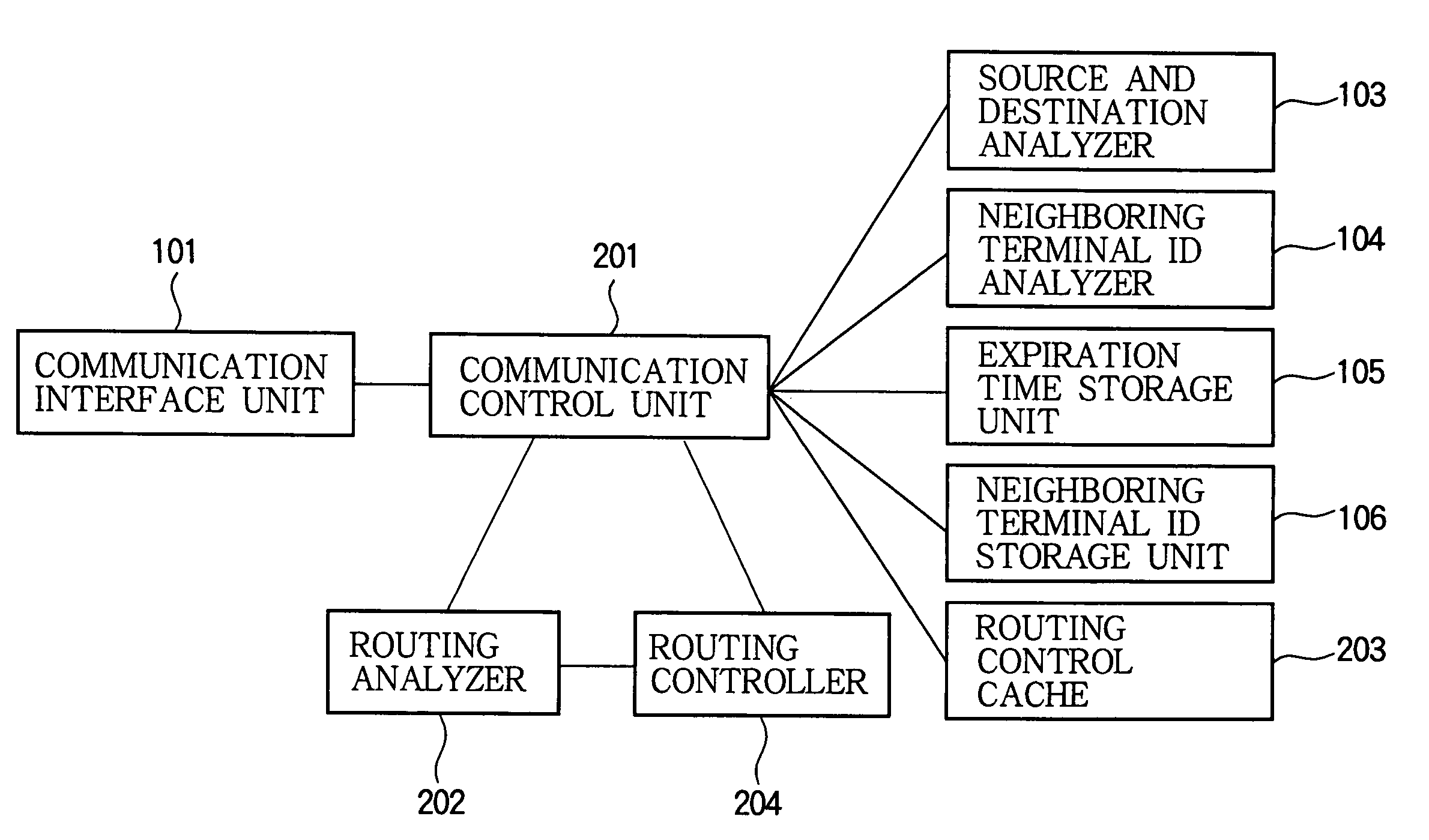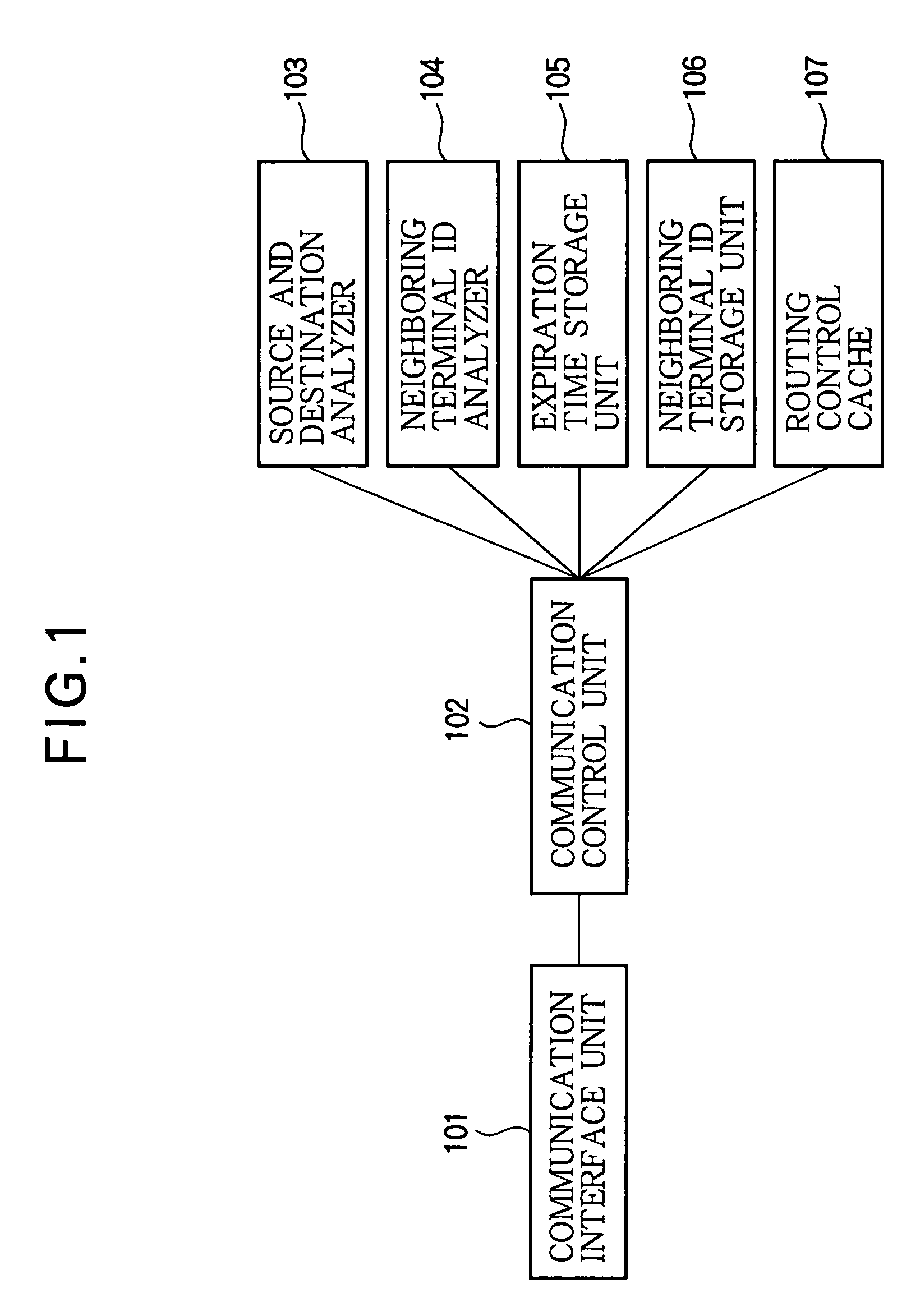Communication terminal and communication network
a terminal and terminal technology, applied in the field of communication networks, can solve the problems of single-path communication process, unstable single-path communication process, broken path, etc., and achieve the effect of effectively using network resources, avoiding radio interference, and stabilizing communication
- Summary
- Abstract
- Description
- Claims
- Application Information
AI Technical Summary
Benefits of technology
Problems solved by technology
Method used
Image
Examples
first embodiment
[0044]Referring to FIG. 1, each communication terminal in the first embodiment has a communication interface unit 101, a communication control unit 102, a source and destination analyzer 103, a neighboring terminal ID analyzer 104, an expiration time storage unit 105, a neighboring terminal ID storage unit 106, and a routing control cache 107, which are interconnected as shown. All of the elements shown in FIG. 1 may be implemented in hardware, but some of them may also be implemented partly or wholly in software executed on a general-purpose computing device such as a microprocessor.
[0045]The communication interface unit 101 interfaces with other communication terminals in the network.
[0046]The communication control unit 102 receives packets from the communication network via the communication interface unit 101, and sends packets to the communication network via the communication interface unit 101. The communication control unit 102 also sends received packets to the source and d...
second embodiment
[0066]Referring to FIG. 7, the communication terminals in the second embodiment have a communication interface unit 101, a communication control unit 201, a source and destination analyzer 103, a routing analyzer 202, a neighboring terminal ID analyzer 104, an expiration time storage unit 105, a neighboring terminal ID storage unit 106, a routing control cache 203, and a routing controller 204, which are interconnected as shown.
[0067]The communication interface unit 101 interfaces with other communication terminals in the network.
[0068]The communication control unit 201 receives packets from the communication network and sends packets to the communication network via the communication interface unit 101. Among the packets sent to the communication network are route command message packets supplied by the routing controller 204.
[0069]The communication control unit 201 sends received packets to the source and destination analyzer 103, neighboring terminal ID analyzer 104, and routing ...
third embodiment
[0094]Referring to FIG. 13, the communication terminals in the third embodiment have a communication interface unit 101, a communication control unit 301, a source and destination analyzer 103, a neighboring terminal ID analyzer 104, an expiration time storage unit 105, a neighboring terminal ID storage unit 106, a hopcount controller 302, and a hopcount cache 303, which are interconnected as shown.
[0095]The communication interface unit 101 interfaces with other communication terminals in the network.
[0096]The communication control unit 301 receives packets from the communication network via the communication interface unit 101, and transmits packets to the communication network. The packets in the third embodiment include a pair of hopcount values indicating the number of hops from the source terminal and the number of hops to the destination terminal. Among the packets received from the network are route request message packets. The communication control unit 301 sends all receive...
PUM
 Login to View More
Login to View More Abstract
Description
Claims
Application Information
 Login to View More
Login to View More - R&D
- Intellectual Property
- Life Sciences
- Materials
- Tech Scout
- Unparalleled Data Quality
- Higher Quality Content
- 60% Fewer Hallucinations
Browse by: Latest US Patents, China's latest patents, Technical Efficacy Thesaurus, Application Domain, Technology Topic, Popular Technical Reports.
© 2025 PatSnap. All rights reserved.Legal|Privacy policy|Modern Slavery Act Transparency Statement|Sitemap|About US| Contact US: help@patsnap.com



